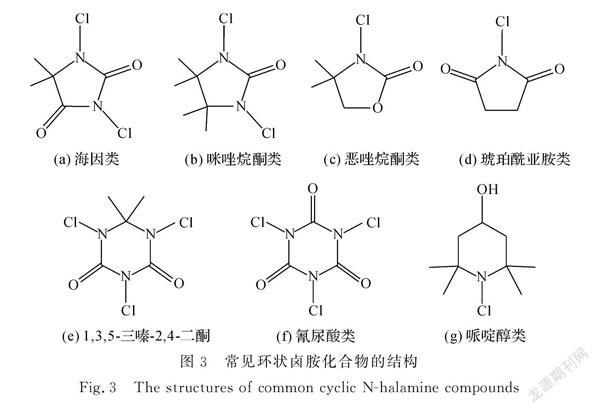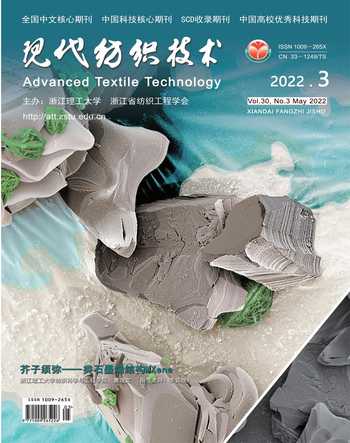基于卤胺化合物抗菌改性合成纤维材料的研究进展
刘超 何斌 汪泽幸 周蓉







摘要:大多数合成纤维属于惰性高分子材料,由于活性基团较少,抗菌改性相对较困难,因此对抗菌剂的选择和改性方法提出了更高要求。卤胺化合物具有广谱长效抗菌、可循环再生、稳定性好等优点被广泛用于纤维材料的抗菌改性。本文从卤胺化合物分类和合成纤维抗菌改性方法两个方面出发,总结了表面接枝、表面涂覆、共混改性和反应挤出等方法对合成纤维进行卤胺化合物抗菌改性的研究进展,并展望了未来合成纤维抗菌改性的发展方向。
关键词:卤胺化合物;合成纤维;抗菌;改性方法
中图分类号:TS102.6文献标志码:A文章编号:1009265X(2022)03002308
Research progress of antibacterial modified synthetic fiber materials
based on Nhalamine compounds
LIU Chao HE Bin WANG Zexing ZHOU Rong
Abstract: Most synthetic fibers are inert polymer materialsand are relatively difficult for antibacterial modification due to fewer active groups, setting higher requirements for the selection and modification methods of antibacterial agents. Nhalamine compounds with the advantages of their broadspectrum, longacting antibacterial, recyclable and good stability are widely used in antibacterial modification of fiber materials. In this paper, based on the classification of Nhalamine compounds and the antibacterial modification methods of synthetic fibers, the research progress of different Nhalamine compounds in the antibacterial modification of synthetic fibers by surface grafting, surface coating, blending modification and reactive extrusion was summarized, and the future development direction of antibacterial modification of synthetic fibers was prospected.
Key words: Nhalamine; synthetic fiber; antibacterial; modification method
卤胺化合物是一种新型的有机抗菌剂,最早由Kovacic等[12]在1969年提出,20 世纪90年代后,Sun等[3]开始致力于高分子卤胺化合物的设计和合成制备。卤胺化合物可定义为含有一个或多个氮卤(N—X)共价键的有机抗菌剂,其分子结构一般如图1所示[4],其中R1,R2一般是无机基团、有机基团、H、Cl、Br等,X表示卤素Cl或Br。根据N—X相邻基团性质不同,可分为酰亚胺结构,酰胺结构或胺结构的卤胺化合物。与其它抗菌剂相比,由于其具有广谱长效抗菌、可再生、稳定性好、对人不产生毒副作用、环境友好等优点[5]而引起了研究者的广泛关注。
1卤胺抗菌剂
1.1抗菌机理
由于N—Br,N—I键在实际应用中不稳定且易分解,因此目前常使用氯胺(N—Cl)化合物作为主要的卤胺抗菌剂,其抗菌机理和可再生循环过程如图2所示[67],N—Cl键在水分子作用下会缓慢分解,逐渐被还原成N—H键,同时释放出的氯正离子(Cl+)具有氧化杀菌作用,可有效杀死多种细菌、病毒等有害微生物。与无机卤素相比,卤胺化合物性能更稳定,腐蚀性更小[8]。杀死这些病菌后,再经过次氯酸盐漂洗,化合物中的N—H 键又可以被氧化形成N—Cl键,再次获得杀菌功能,因此卤胺化合物的抗菌性能具有循环可再生性。研究认为卤胺化合物中N—X共价键和游离的卤正离子是主要的活性单体,均表现出较强的正电性和氧化性能,可以与微生物中的活性官能团反应,通过N—X中的卤正离子直接转移到微生物表面,或卤正离子被释放到溶液中再与微生物接触,从而抑制和破坏微生物体内的酶活性来达到杀菌的目的[910]。
1.2环状和非环状卤胺化合物
根据卤胺化合物分子结构中N—X所处位置的不同,可将其分为可分为环状和非环状卤胺化合物。环状卤胺化合物是指N—X共价键在环状结构内部,目前合成的环状卤胺化合物多为五元环和六元环结构。环状卤胺化合物由于不含有α氢,阻止了脱卤化氢过程,因此抗菌性能更稳定,持续时间更长[1112]。常见的环状卤胺化合物有五元环结构的海因类(5,5二甲基海因)、咪唑烷酮类、恶唑烷酮类、琥珀酰亚胺类,以及六元环结构的1,3,5三嗪2,4二酮,氰尿酸类和哌啶醇类等[4],其结构如图3所示。
五元環结构中以含有海因结构的卤胺化合物最常见。Eknoiam等[13]基于BuchererBergs 反应,合成出了一系列海因环状卤胺化合物,如5甲基5(4′甲基苯基)海因、3(5′甲基5′海因)乙酰苯胺[14],5甲基5(3′氨基苯基)海因[15]等。此外,以5,5二甲基海因作为反应物,通过取代反应可以制备不同连接基团的卤胺化合物,如3(2,3二羟基丙基)5,5二甲基海因,3环氧基5,5二甲基海因,三乙氧基5,5二甲基海因等都是基于该方法制备得到[9, 16]。除五元环结构的环状卤胺化合物以外,Li等[17]和Ma等[18]基于异氰尿酸,制备出了多种六元环卤胺化合物,如1环氧丙基s三嗪2,4,6三酮和1(2,3二羟基丙基)s三嗪2,4,6三酮。
非环状卤胺化合物是指N—X共价键不在环状结构内部。目前常见的主要有胺类、酰胺类、多糖、三聚氰胺、氨基酸等化学结构的非环状卤胺化合物,如图4所示。由于其结构较开放,非环状卤胺化合物对水解更敏感。Pastoriza 等[1920]将有机胺与具有氧化性的卤素化合物反应,制成了多种有机胺类非环状卤胺化合物。酰胺类非环状卤胺化合物通常采用乙烯基酰胺类单体聚合后氯化得到,如丙烯酰胺(AAM),甲基丙烯酰胺(MAM),N叔丁基丙烯酰胺(NTAAM)和N叔丁基甲基丙烯酰胺(NTMAM)等,已被研究人员用于棉纤维和聚酯(PET)、聚丙烯(PP)和聚丙烯腈(PAN)等合成纤维的表面抗菌整理[2123]。部分多糖类聚合物通过氯化处理后,可以成为非环状卤胺化合物,如常用的壳聚糖。将甲壳素纳米纤维膜与次氯酸反应可以制成具有抗菌性能的纳米纤维[24]。Cao等[25]将氨基壳聚糖氯化处理制成具有抑菌效果的生物膜,但其抗菌活性不强。Li等[26]、Cheng等[27]采用海因环接枝改性壳聚糖,制备出抗菌性能优异的卤胺化合物。
2卤胺化合物抗菌改性合成纤维材料
目前卤胺化合物已被广泛应用于水消毒,除臭,抗菌涂料和卫生材料等方面,同时在纤维织物,非织造材料和聚合物原料的抗菌改性方面也有大量应用。由于棉纤维表面含有较多羟基,可作为反应基团与卤胺单体进行接枝或交联反应,是卤胺化合物抗菌改性应用研究较多的一种纤维材料。而大多数合成纤维属于惰性高分子材料,卤胺化合物对其进行抗菌改性相对较困难,工艺流程较复杂,目前常用的合成纤维抗菌改性方法主要有:表面接枝、表面涂覆、共混改性和反应挤出等。
2.1表面接枝
表面接枝主要采用自由基接枝聚合方法在材料表面接枝卤胺前驱体,然后经氯漂后得到卤胺化合物抗菌改性材料。Huang等[28]和Tamizifar等[29]采用该方法,将不同的乙烯基卤胺单体,如3烯丙基5,5二甲基乙内酰脲(ADMH),N乙烯基吡咯烷酮(VP),4氰基苯乙烯(CnSt),甲基丙烯酸四甲基4哌啶基酯(TMPM),AAM和2丙烯酰胺基2甲基1丙烷磺酸(AMPS)等,在过氧化物引发剂作用下接枝到PET纤维表面,氯化后的PET纤维表现出优异的抗菌性能。同时采用Hansen溶解度参数理论定量分析接枝体系中化学成分(包括单体,引发剂,聚酯和溶剂)的相互作用和亲和力,用于控制PET纤维上的自由基接枝聚合[30]。此外,研究发现在接枝反应体系中添加交联剂可以促进乙烯基单体的接枝[31]。
Xi等[32]通过气相辅助聚合(VAP)方法对PET织物进行抗菌改性,VAP工艺不需要有机溶剂且抗菌单体消耗量少[3334]。先用等离子处理PET织物使其表面产生自由基,然后将ADMH气化并接枝聚合在PET织物表面。氯化后,改性的PET織物对金黄色葡萄球菌和大肠杆菌的杀菌率达到80%,可承受超过30次的洗涤试验。
通过在材料表面接枝互穿网络高分子来进行抗菌改性是目前一个新的研究方向[35],通过交联可以有效提高卤胺前驱体的接枝率,增加材料表面的活性官能团,进而提高抗菌性能。Liu等[36]、Zhao等[3738]通过在材料表面生成热塑性半互穿聚合物网络(IPN),如图5所示,将聚丙烯酰胺(PAM)或聚甲基丙烯酰胺(PMAM)交联固定在化学惰性热塑性聚合物(如PP或PET)基材的表面上。氯化后转化为N卤胺化合物,所得材料显示出持久而有效的抗菌活性。此外,由于改性仅限于聚合物材料的一侧,因此对聚合物纤维材料的表面形态,透气性和拉伸强度影响较小。
2.2表面涂覆法
Liu等[39]分别合成了两种高分子卤胺前驱体:阳离子型聚3(丙烯酰胺丙基)三甲基氯化铵和阴离子型聚(2丙烯酰胺基2甲基丙磺酸钠盐),并采用layerbylayer(LbL)组装技术[40],分别通过浸渍和喷涂法将其涂覆在聚丙烯纺粘非织造材料上,如图6所示。抗菌试验表明,浸渍处理的试样能分别在60 min和30 min内能灭活5 log以上的金黄色葡萄球菌和大肠杆菌,喷涂法处理的试样中活性氯含量相对较低,但也能在60 min内使细菌失活。所有试样在黑暗和光照条件下均表现出良好的储存稳定性,且涂层对试样透气性影响较小。Denisrohr等[41]也采用LbL技术将聚乙烯亚胺和聚丙烯酸涂覆至厚度为150 μm的聚丙烯膜上,浸渍或喷涂法制成的试样氯漂后对李斯特菌的抗菌效率均达到99.999%以上。
Cerkez等[4243]分别合成了含乙内酰脲的N卤胺均聚物(HP),以及含乙内酰丙烯酰胺(HA)、甲基丙烯酸缩水甘油酯和乙基三甲基氯化铵的水分散性三元共聚物(HAcoGMcoMETAC),再采用浸轧法分别涂覆至PET织物表面,涂层织物杀菌性能优异,并具有优良的耐洗性和耐紫外线性能。此外,该团队还基于HA合成了阴离子和阳离子型N卤胺共聚物,分别采用LbL技术和浸轧法将共聚物沉积在PP非织造材料表面[44]。结果显示,LbL多层沉积试样所需的灭活时间比浸轧法的单层沉积试样更长,因为活性氯从多层结构中释放速度较慢,因此浸轧法形成的单层沉积更适合用于一次性产品的抗菌处理。
Ren等[14]将合成的卤胺前驱体3(5甲基5′乙内酰脲基)乙酰苯胺涂覆在静电纺PAN纳米纤维上,经氯漂后,5 min接触时间内可杀灭5 log金黄色葡萄球菌和大肠杆菌。张淑敏等[45]采用浸渍法将共聚合成的3(3′丙烯酸丙酯)5,5二甲基海因乙酸乙烯酯整理到PP非织造材料上,结果显示改性后的试样在30 min内能使所有金黄色葡萄球菌和大肠杆菌失活。Demir等[46]将MC通过表面涂覆的方式对不同面密度的PP熔喷过滤材料进行抗菌改性,接触10 min后能完全灭活大肠杆菌和金黄色葡萄球菌。此外,还设计了含菌气溶胶过滤实验,结果显示该试样在3 h后仍具有抗菌功效。
Chen等[47]通过硅烷醇解反应,将合成的4乙基4(羟甲基)恶唑烷22(EHMO)卤胺前体接枝到聚甲基氢硅氧烷(PMHS)上。氯化处理后再将其溶解于超临界二氧化碳中,最终在PP纤维表面形成厚度为72 nm的N卤胺聚硅氧烷涂层,该涂层能在10 min接触时间后使金黄色葡萄球菌和大肠杆菌完全失活,同时具有良好的可再生性、耐洗涤性、储存稳定性和耐紫外线辐射等。
2.3共混改性法
共混改性法是将含有N卤胺官能团的聚合物与其它高分子聚合物共混,再经过纺丝得到抗菌纤维材料的方法。N卤胺改性聚合物材料的抗菌性能应在很大程度上取决材料表面的N卤胺功能位点数量,即纤维越细,比表面积越大,处于纤维表面的N卤胺功能位点越多,纤维与微生物的接触面积越多,则材料而具有更高效的抗菌性能,因此,可以通过静电纺丝等方法将共混聚合物制备成抗菌纳米纤维膜。
李蓉等[48]将聚乙烯醇(PVA)与3环氧丙基5,5二甲基海因改性壳聚糖(CTSGH)共混溶解后,再通过静电纺丝工艺将混合物制成直径为800 nm左右的纳米纤维膜,经氯漂后获得高效抗菌性能。黄程博等[49]将合成的海因单体3(4′乙烯苄基)5,5二甲基海因(VBDMH)与甲基丙烯酸甲酯(MMA)进行聚合反应,制成新型的抗菌卤胺高分子前驱体,再与PAN共混溶解,最后通过静电纺丝形成抗菌PAN纳米纤维膜,可在30 min内杀灭大肠杆菌和金黄色葡萄球菌。此外,还将MC与PAN混合后制成具有抗菌性能的PAN/MC纳米纤维,10 min接触时间后能杀灭6 log以上的金黄色葡萄球菌和大肠杆菌[50]。
Luo等[51]将2,2,6,6四甲基4哌啶醇氯化后接枝到聚甲基丙烯酸甲酯(PMMA)大分子链上制成N卤胺抗菌聚合物(AP),然后将AP和热塑性聚氨酯(TPU)分别溶解于N,N二甲基乙酰胺后按一定比例共混,采用静电纺丝工艺将共混物加工成纳米纤维膜。结果表明,制成的纳米纤维膜对金黄色葡萄球菌、大肠杆菌、以及酿酒酵母和曲霉菌等真菌均表现出较强的抗菌功效,可用于伤口抗菌敷料的制备。
Bai等[52]将环状N卤胺化合物1,3二氯5,5二甲基乙内酰脲(DCDMH)和1,3二溴5,5二甲基乙内酰脲(DBDMH)分别或同时与PMMA混合,溶解后通过静电纺丝工艺制纳米纤维,大肠杆菌分别与 PMMADBDMH 和 PMMADCDMH 接触 60 min 和 90 min后被完全杀灭,循环抗菌测试表明,经过5次循环测试后,初纺纤维可以保持抗菌性能。然而,对于产业化应用而言,PMMA纤维仍存在机械强度和柔软性不足等问题,需要进一步研究改善。
Tian等[53]通过亲核取代反应将5、5二甲基乙内酰脲和三甲胺接枝到聚苯乙烯上(PS),合成了一种新型聚合物(PSDT),该聚合物上同时具有卤胺和阳离子季铵盐基团,然后将其与聚氨酯(PU)混合制成溶液,再通过特殊的静电纺丝技术制成了PSDT / PU纳米纤维蛛网膜,由于纳米蛛网具有多孔结构,使得静电纺丝膜表现出高效低阻空气过滤性能,且氯化后的PSDT/PU纳米蛛网能在2 min显示出优异的杀菌和杀病毒性能(>99.999%),对细菌的拦截效率达到99.77%。
2.4反应挤出法
Badrossamay等[21, 5458]通过熔融反应挤出法分别将AAM、MAM、NTAAM、NTMAM、VBDMH、2,4二氨基6二烯丙基氨基1,3,5三嗪(NDAM)和ADMH等单体成功接枝到PP或聚乙烯(PE)大分子主链上,对比分析了过氧化物引发剂的浓度和类型,反应温度和反应挤出的转速对接枝聚合物反应的影响。然后将改性后的热塑性聚合物作为分散相与醋酸丁酸纤维素(CAB)按一定比例混合,由于两者互不相容从而形成了不相容共混体系,如图7所示。共混物熔融后,热塑性聚合物会以球形状分散于CAB中,挤出时由于压力作用产生拉伸变形而成为椭圆形,熔体被进一步拉伸变形,在基体材料CAB中的热塑性聚合物形成连续纳米纤维,混合物冷却固化后,再通过大量的丙酮萃取将CAB去除,最终得到平均直径为600 nm的纳米纤维。氯化后的纤维对大肠杆菌和金黄色葡萄球菌表现出强效的抗菌性能。
Wang等[5962]采用反应挤出法将NDAM单体熔融接枝聚合到亲水性聚乙烯醇co乙烯共聚物(PVAcoPE)上,研究了过氧化物引发剂的浓度和原料中乙烯含量对NDAM接枝率的影响。并采用不相容共混体系制备成平均直径为200 nm的纤维,将纳米纤维与异丙醇按一定比例混合后,经搅拌机粉碎制成分散均匀的纳米纤维悬浮液,通过高压喷枪喷涂在非织造基布上,经氯漂后制成了具有抗菌效果的水过滤微滤膜。
3结语
卤胺化合物通过表面接枝和交联、表面涂覆等方法对合成纤维材料进行抗菌整理,是目前比较常用的抗菌改性方法,具有操作简单,适用范围广,工艺流程短等优点,但可能存在耐洗牢度较差等问题。而共混和反应挤出改性是对合成纤维原料进行改性,抗菌效果更持久,耐洗性更好,但纤维材料抗菌改性过程较复杂,对抗菌剂和原料的选择要求更高。长远来看,通过抗菌剂直接对高分子聚合物原料进行改性是未来的发展趋势,通过实现工业化生产直接用于制备抗菌纤维材料,产品可广泛用于医疗卫生、过滤、擦拭材料、个体防护,阻隔防护等领域,具有廣阔的应用前景。
参考文献:
[1]KOVACIC P, LOWERY M K. Chemistry of Nhalamines. XII. Amination of alkyl halides with trichloraminealuminum chloride[J]. The Journal of Organic Chemistry, 1969, 34(4): 911917.
[2]KOVACIC P, LOWERY M K, FIELD K W. Chemistry of Nbromamines and Nchloramines[J]. Chemical Reviews, 1970, 70(6): 639665.
[3]SUN G, WHEATLEY W B, WORLEY S D. A new cyclic Nhalamine biocidal polymer[J]. Industrial & Engineering Chemistry Research, 1994, 33(1): 168170.
[4]HUI F, DEBIEMMECHOUVY C. Antimicrobial Nhalamine polymers and coatings: A review of their synthesis, characterization, and applications[J]. Biomacromolecules, 2013, 14(3): 585601.
[5]LI L, JUNG J, MA W, et al. Enhanced antimicrobial and antifungal property of twodimensional fibrous material assembled by Nhalamine polymeric electrolytes[J]. Materials Science and Engineering C, 2020, 115: 111122.
[6]SUN X, CAO Z, PORTEOUS N, et al. Amine, melamine, and amide Nhalamines as antimicrobial additives for polymers[J]. Industrial & Engineering Chemistry Research, 2010, 49(22): 1120611213.
[7]REN X H, KOU L, KOCER H B, et al. Antimicrobial coating of an Nhalamine biocidal monomer on cotton fibers via admicellar polymerization[J]. Colloids and Surfaces A: Physicochemical and Engineering Aspects, 2008, 317(1/2/3): 711716.
[8]WORLRY S D, WILLAMS D E, CRAWFROD R A. Halamine water disinfectants[J]. Critical Reviews in Enviromental Control, 1988, 18(2): 133175.
[9]REN X H, KOCER H B, WORLEY S D, et al. Rechargeable biocidal cellulose: Synthesis and application of 3(2,3dihydroxypropyl)5,5dimethylimidazolidine2,4dione[J]. Carbohydrate Polymers, 2009, 75(4): 683687.
[10]BARNELA S B, WORLEY S D, WILLAMS D E. Syntheses and antibacterial activity of new Nhalamine compounds[J]. Journal of Pharmaceutical Sciences, 1987, 76(3): 245247.
[11]AHMED A E S I, HAY J N, BUSHELL M E, et al. Optimizing halogenation conditions of Nhalamine polymers and investigating mode of bactericidal action[J]. Journal of Applied Polymer Science, 2009, 113(4): 24042412.
[12]CHOI K, NAM M J, KIM J Y, et al. Synthesis and characterization of biocidal poly(oxyethylene)s having Nhalamine side groups[J]. Macromolecular Research, 2011, 19(12): 12271232.
[13]EKNOIAN M W, WORLEY S D, Harris J M. New biocidal NhalaminePEG polymers[J]. Journal of Bioactive and Compatible Polymers, 1998, 13(2): 136145.
[14]REN X H, AKDAG A, ZHU C Y, et al. Electrospun polyacrylonitrile nanofibrous biomaterials [J]. Journal of Biomedical Materials Research Part A, 2009, 91A(2): 385390.
[15]LEE J, BROUGHTON R M, AKDAG A, et al. Preparation and application of anstriazinebased novel Nhalamine biocide for antimicrobial fibers[J]. Fibers and Polymers, 2007, 8(2): 148154.
[16]LIANG J, CHEN Y J, REN X H, et al. Fabric treated with antimicrobial Nhalamine epoxides[J]. Industrial & Engineering Chemistry Research, 2007, 46(20): 64256429.
[17]LI L, MA K K, LIU Y, et al. Biocompatible antimicrobial cotton modified with tricarbimidebased Nhalamine [J]. Polymers for Advanced Technologies, 2014, 25(9): 963968.
[18]MA K K, LIU Y, XIE Z, et al. Synthesis of novel Nhalamine epoxide based on cyanuric acid and its application for antimicrobial finishing [J]. Industrial & Engineering Chemistry Research, 2013, 52(22): 74137418.
[19]PASTORIZA C, ANTELO J M, CRUGEIRAS J. Reactions of chlorination withtertbutyl hypochlorite (TBuOCl)[J]. Journal of Physical Organic Chemistry, 2014, 27(12): 952959.
[20]PASTORIZA C, ANTELO J M, CRUGEIRAS J. Use of NchloroNmethylptoluenesulfonamide in Nchlorination reactions[J]. Journal of Physical Organic Chemistry, 2013, 26(7): 551559.
[21]BADROSSAMAY M R, SUN G. Acyclic halamine polypropylene polymer: Effect of monomer structure on grafting efficiency, stability and biocidal activities[J]. Reactive and Functional Polymers, 2008, 68(12): 16361645.
[22]LUO J, SUN Y. Acyclic Nhalaminebased fibrous materials: Preparation, characterization, and biocidal functions [J]. Journal of Polymer Science Part A Polymer Chemistry, 2006, 44(11): 35883600.
[23]YLDIZ O, CERKEZ I, KOCER H B, et al. N(hydroxymethyl)acrylamide as a multifunctional finish to cotton and a tether for grafting methacrylamide for biocidal coatings[J]. Journal of Applied Polymer Science, 2013, 128(6): 44054410.
[24]DUTTA A K, EGUSA M, KAMINAKA H, et al. Facile preparation of surface Nhalamine chitin nanofiber to endow antibacterial and antifungal activities[J]. Carbohydrate Polymers, 2015, 115: 342347.
[25]CAO Z, SUN Y. Nhalaminebased chitosan: Preparation, characterization, and antimicrobial function[J]. Journal of Biomedical Materials Research Part A, 2008, 85(1): 99107.
[26]LI R, HU P, REN X H, et al. Antimicrobial Nhalamine modified chitosan films[J]. Carbohydrate Polymers, 2013, 92(1): 534539.
[27]CHENG X L, MA K K, LI R, et al. Antimicrobial coating of modified chitosan onto cotton fabrics[J]. Applied Surface Science, 2014, 309: 138143.
[28]HUGANG C, CHEN Y B, SUN G, et al. Disinfectant performance of a chlorine regenerable antibacterial microfiber fabric as a reusable wiper[J]. Materials, 2019, 12(1): 127.
[29]TAMIZIFAR M, SUN G. Control of surface radical graft polymerization on polyester fibers by using Hansen solubility parameters as a measurement of the affinity of chemicals to materials[J]. RSC Advances, 2017, 7(22): 1329913303.
[30]TAMIZIFAR M, SUN G. Surface modification of poly(ethylene terephthalate)fibers via controlled radical graft polymerization[J]. Journal of Applied Polymer Science, 2018, 135(11): 45990.
[31]TAMIZIFAR M, SUN G. Controlled surface functionalization of poly(ethylene terephthalate)fibers with varied vinyl monomers via radical graft copolymerization[J]. Materials Today Communications, 2018, 17: 124132.
[32]XI G H, XIUY L, WANG L, et al. Antimicrobial Nhalamine coatings synthesized via vaporphase assisted polymerization[J]. Journal of Applied Polymer Science, 2015, 132(15): 41824.
[33]ANDOU Y, JEONG J M, NISHIDA H, et al. Simple procedure for polystyrenebased nanocomposite preparation by vaporphaseassisted surface polymerization[J]. Macromolecules, 2009, 42(20): 79307935.
[34]ANDOU Y, JEONG J M, HIKI S, et al. Design of nanocomposites by vaporphase assisted surface polymerization[J]. Macromolecules, 2009, 42(3): 768772.
[35]王留陽,王芳颖.卤胺在织物抗菌改性中的应用进展[J].上海纺织科技,2011,39(11):811.
WANG Liuyang, WANG Fangying. Progress of halamine applications in the preparation of antimicrobial fabrics[J]. Shanghai Textile Science & Technology, 2011, 39(11): 811.
[36]LIU S, ZHAO N, RUDENJA S. Surface interpenetrating networks of poly(ethylene terephthalate)and polyamides for effective biocidal properties[J]. Macromolecular Chemistry and Physics, 2010, 211(3): 286296.
[37]ZHAO N, ZHANEL G G, LIU S. Regenerability of antibacterial activity of interpenetrating polymeric Nhalamine and poly(ethylene terephthalate)[J]. Journal of Applied Polymer Science, 2011, 120(1): 611622.
[38]ZHAO N, LIU S. Thermoplastic semiIPN of polypropylene (PP)and polymeric Nhalamine for efficient and durable antibacterial activity[J]. European Polymer Journal, 2011, 47(8): 16541663.
[39]LIU Y, QIAO M, LV C, et al. Nhalamine polyelectrolytes used for preparation of antibacterial polypropylene nonwoven fabrics and study on their basal cytotoxicity and mutagenicity[J]. International Journal of Polymeric Materials and Polymeric Biomaterials, 2020, 69(15): 971978.
[40]LIU Y, LI J, CHENG X, et al. Selfassembled antibacterial coating by Nhalamine polyelectrolytes on a cellulose substrate[J]. Journal of Materials Chemistry B, 2015, 3(7): 14461454.
[41]DENISROHR A, BASTARRACHEA L J, GODDARD J M. Antimicrobial efficacy of Nhalamine coatings prepared via dip and spray layerbylayer deposition[J]. Food and Bioproducts Processing, 2015, 96: 1219.
[42]CERKEZ I, WORLEY S D, BROUGHTON R M, et al. Antimicrobial coatings for polyester and polyester/cotton blends[J]. Progress in Organic Coatings, 2013, 76(7/8): 10821087.
[43]CERKEZ I, KOCER H B, WOLEY S D, et al. Antimicrobial functionalization of poly(ethylene terephthalate)fabrics with waterborne Nhalamine epoxides[J]. Journal of Applied Polymer Science, 2016, 133(9): 43088.
[44]CERKEZ I, WOLEY S D, BROUGHTON R M, et al. Antimicrobial surface coatings for polypropylene nonwoven fabrics[J]. Reactive and Functional Polymers, 2013, 73(11): 14121419.
[45]張淑敏,任学宏,李清芳.卤胺抗菌共聚物改性丙纶无纺布的研究[J].化工新型材料,2018,46(4): 201204.
ZHANG Shumin, REN Xuehong, LI Qingfang. Study on antibacterial finishing of PP nonwoven fabric by Nhalamine copolymer[J]. New Chemical Materials, 2018, 46(4): 201204.
[46]DEMIR B, CERKEZ I, WORLEY S D, et al. Nhalaminemodified antimicrobial polypropylene nonwoven fabrics for use against airborne bacteria[J]. ACS Applied Materials & Interfaces, 2015, 7(3): 17521757.
[47]CHEN Y, HE Q K, REN G Y, et al. Preparation of biocidal 4ethyl4(hydroxymethyl)oxazolidin2onebased Nhalamine polysiloxane for impregnation of polypropylene in supercritical CO2[J]. Journal of Applied Polymer Science, 2018, 135(33): 46624.
[48]李蓉,刘喆,任学宏.环状卤胺化合物改性壳聚糖/PVA纳米纤维的制备与表征[J].材料导报,2013,27(14):4548.
LI Rong, LIU Zhe, REN Xuehong. Preparation and characterization of cyclic Nhalamine modified chitosan/PVA nanofibers[J]. Materials Reports, 2013, 27(14): 4548.
[49]黄程博,任学宏.静电纺抗菌聚丙烯腈纳米纤维膜制备及其性能[J].纺织学报,2019,40(5):711.
HUANG Chengbo, REN Xuehong. Synthesis and properties of antibacterial polyacrylonitrile nanofiber membrane[J]. Journal of Textile Research, 2019, 40(5): 711.
[50]HUANG C B, LIU Y, LI Z G, et al. Nhalamine antibacterial nanofibrous mats based on polyacrylonitrile and Nhalamine for protective face masks[J]. Journal of Engineered Fibers and Fabrics, 2019, 14: 18.
[51]LUO H, YIN X Q, TAN P F, et al. Engineering an antibacterial nanofibrous membrane containing Nhalamine for recyclable wound dressing application[J]. Materials Today Communications, 2020, 23: 100898.
[52]BAI R, ZHANG Q, LI L L, et al. Nhalaminecontaining electrospun fibers kill bacteria via a contact/release codetermined antibacterial pathway[J]. ACS Applied Materials & Interfaces, 2016, 8(46): 3153031540.
[53]TIAN CC, WU F, JIAO W L, et al. Antibacterial and antiviral Nhalamine nanofibrous membranes with nanonet structure for bioprotective applications[J]. Composites Communications, 2021, 24: 100668.
[54]BADROSSAMAY M R, SUN G. A study of radical graft copolymerization on polypropylene during extrusion using two peroxide initiators[J]. Polymer International, 2010, 59(2): 155161.
[55]BADROSSAMAY M R, SUN G. A study on melt grafting of Nhalamine moieties onto polyethylene and their antibacterial activities[J]. Macromolecules, 2009, 42(6): 19481954.
[56]BADROSSAMAY M R, SUN G. Graft polymerization of Ntertbutylacrylamide onto polypropylene during melt extrusion and biocidal properties of its products[J]. Polymer Engineering & Science, 2009, 49(2): 359368.
[57]BADROSSAMAY M R, SUN G. Durable and rechargeable biocidal polypropylene polymers and fibers prepared by using reactive extrusion[J]. Journal of Biomedical Materials Research Part B Applied Biomaterials, 2009, 89B(1): 93101.
[58]BADROSSAMAY M R, SUN G. Preparation of rechargeable biocidal polypropylene by reactive extrusion with diallylamino triazine[J]. European Polymer Journal, 2008, 44(3): 733742.
[59]WANG D, SUN G, CHIOU B S. A highthroughput, controllable, and environmentally benign fabrication process of thermoplastic nanofibers[J]. Macromolecular Materials and Engineering, 2007, 292(4): 407414.
[60]WANG D, LIU N, XU W L, et al. Layerbylayer structured nanofiber membranes with photoinduced selfcleaning functions[J]. The Journal of Physical Chemistry C, 2011, 115(14): 68256832.
[61]WANG D, SUN G. Formation and morphology of cellulose acetate butyrate (CAB)/polyolefin and CAB/polyester in situ microfibrillar and lamellar hybrid blends[J]. European Polymer Journal, 2007, 43(8): 35873596.
[62]WANG D, XU W L, SUN G, et al. Radical graft polymerization of an allyl monomer onto hydrophilic polymers and their antibacterial nanofibrous membranes[J]. ACS Applied Materials & Interfaces, 2011, 3(8): 28382844
收稿日期:20210623網络出版日期:20211020
基金项目:湖南省教育厅项目(18C0693);湖南工程学院青年科研项目(XJ1802)
作者简介:刘超(1985-),女,湖南衡阳人,博士研究生,主要从事非织造过滤材料制备及性能方面的研究。

